Loch Katrine Emergency Dam Project (2024)
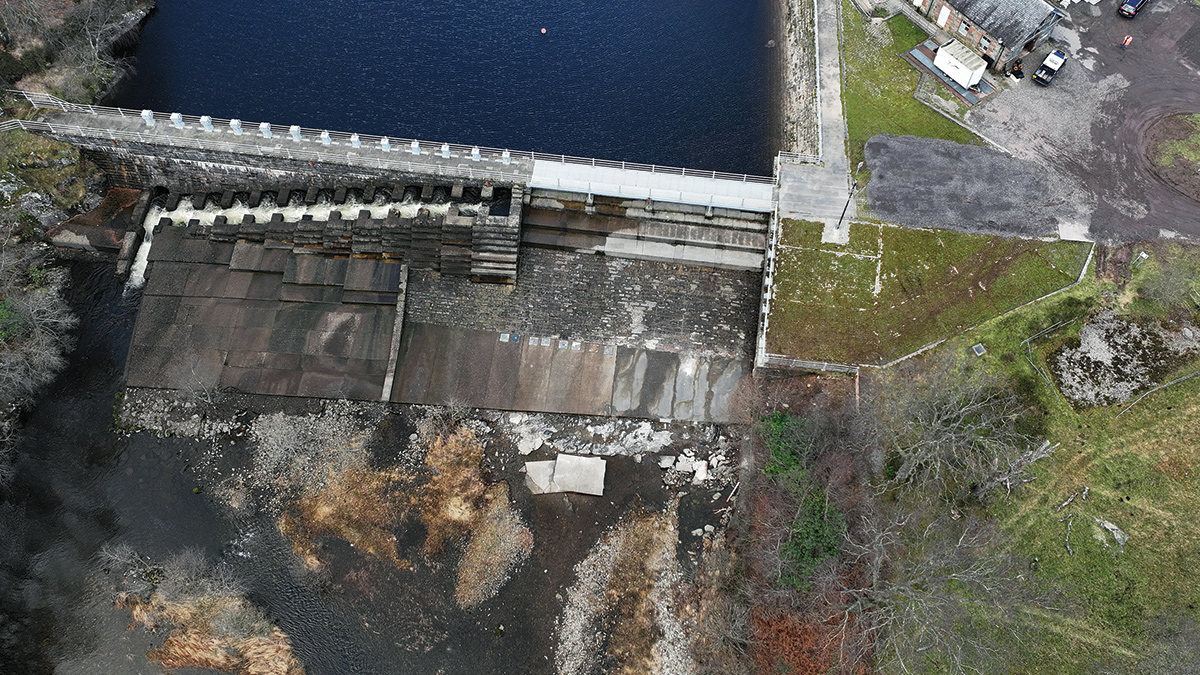
Looking north over Katrine Dam - Courtesy of Whitehouse Studios
Loch Katrine, a freshwater loch situated in the Trossachs area of the Scottish Highlands, is not only a natural beauty but also a critical water resource for Glasgow. The Emergency Dam Project was initiated in response to a severe storm in mid-October 2023, which caused significant damage to the dam’s spillway. The loch, approximately 8 miles long and 1 mile wide at its widest point, runs the length of Strath Gartney. The reservoir was originally formed by constructing a dam across the outlet channel at the eastern end of Loch Katrine, raising the natural loch level and significantly increasing its capacity to supply water.
History
Victorians considered the supply of clean water to be the cornerstone of a civilised society. Glasgow and other major cities in the UK suffered major outbreaks of Cholera in the middle of the 19th century, which were attributed to polluted water supplies. In 1848, a Public Health Act was passed by Parliament to promote the supply of clean water. At this time, schemes were being prepared to provide clean water supplies to all major conurbations throughout the British Isles.
The eminent engineer John Frederic Bateman selected Loch Katrine as an appropriate source of water for Glasgow, and led a team of engineers who translated the scheme into reality by raising the water height at Loch Katrine, constructing a 26-mile-long aqueduct terminating at the Mugdock (storage) reservoir.
Loch Katrine and associated aqueducts are still as efficient and environmentally friendly now as they were when built due to the fact they take water by gravity from Loch Katrine to Milngavie without the need for pumping, before it is distributed to customers.
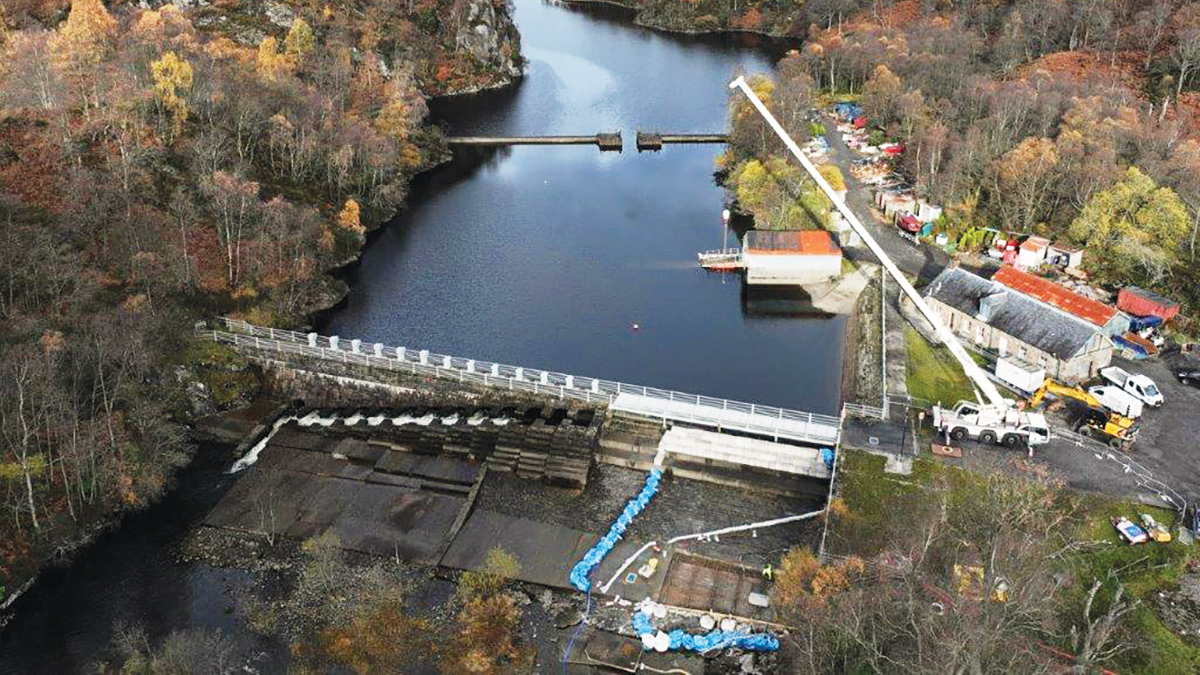
Aerial of the dam repair pre-concrete – Courtesy of Whitehouse Studios
On 14 October 1859, the Loch Katrine-Mugdock Waterworks, as they were originally known, was opened by Queen Victoria in a ceremony at the Commissioners’ Cottage. A clean water supply flowed into the north of Glasgow by 1860.
At the ceremony, Queen Victoria said:
“It is with much gratification that I avail myself of this opportunity of inaugurating a work which, both in its conception and its execution, reflects so much credit on its promoters, and is so calculated to improve the health and comfort of your vast population, which is rapidly increasing round the great centre of manufacturing industry in Scotland.
“Such work is worthy of the enterprise and philanthropy of Glasgow, and I trust it will be blessed with complete success. I desire that you convey to the great community which you represent my warmest wishes for their continued prosperity and happiness.”
Later that century, chief engineer James Gale deemed that the storage capacity of Loch Katrine should be increased and that a second line of aqueducts and another storage reservoir should be constructed at Craigmaddie above Milngavie.
The reservoirs represent an outstanding example of Victorian municipal engineering and, as with many feats of engineering from this time, the adventurism, innovation, and quality of workmanship, are outstanding. The engineering design and construction skills employed to supply Glasgow with clean water from Loch Katrine are truly awe-inspiring.
Project drivers
Water that flows through the aqueducts from Loch Katrine goes on to supply 1.3 million people across much of Greater Glasgow and as far east as West Lothian and to areas like Grangemouth and the Ineos refinery; which is crucially important to Scotland and the UK.
The project was driven by the urgent need to repair the spillway to prevent a potential dam failure. The detachment of concrete apron slabs during the October 2023 storm event posed a significant risk, prompting the formation of an emergency recovery team within Scottish Water.
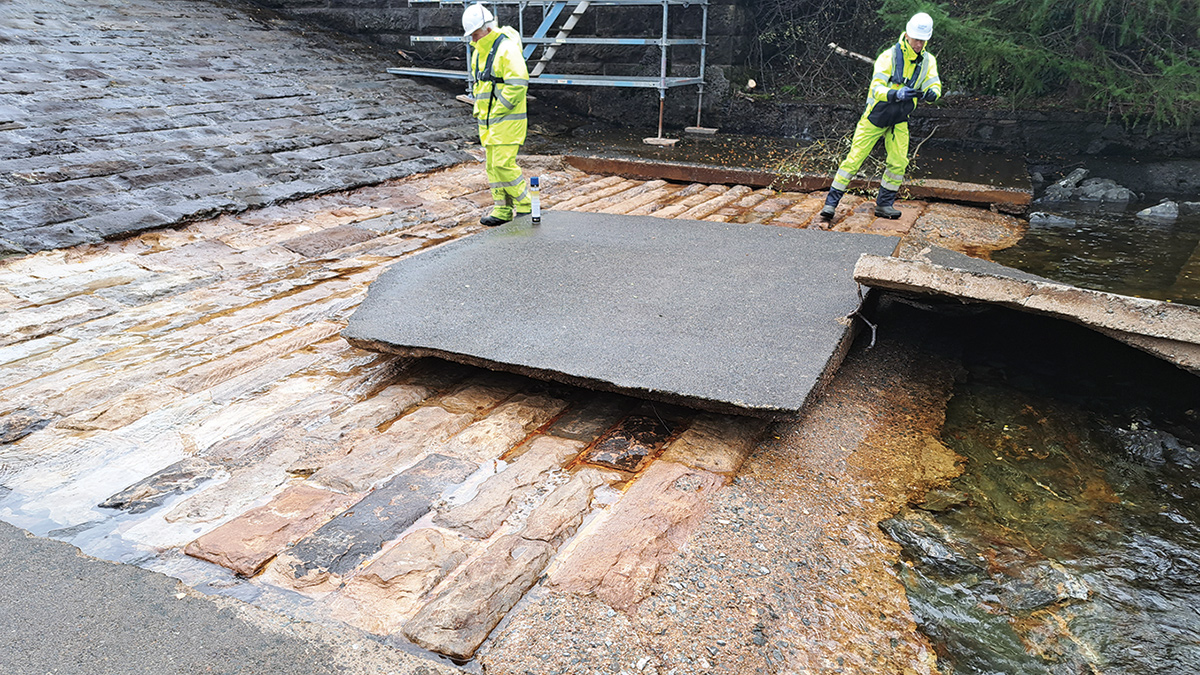
Detached concrete apron slabs – Courtesy of George Leslie Ltd
Loch Katrine Dam Repairs: Supply chain – key participants
- Principal contractor/designer: George Leslie Ltd
- Designer/technical advisor: Mott MacDonald
- Drilling works for anchor rods: Albion Drilling
- Coring of pressure relief holes: Beattie Demolition
- Joiners for formwork: Beatties FRC
- Tree clearance: Caledonian Tree Services
- Concrete pumping: Camfaud Concrete Pumps
- Reinforcement: Central Rebar
- Anchor plates: HK Gillies
- Interlocking blocks: Mellex Group Ltd
- Scaffolding/access: Peoples Safety Scaffolding
- Grout for anchor rods: Resapol
- Pumps: Selwood
- Welfare buildings: Wernick Hire
- Project photography/drone footage: Whitehouse Studios
Optioneering & design
The design and construction approach focused on ensuring the safety of both workers and the public while addressing the immediate risks. George Leslie Ltd, with the assistance of Mott MacDonald, was engaged to repair the damaged areas.
The main tasks involved installation of Legato blocks, as part of the temporary works design, reservoir drawdown, silt mitigation, drilling and fixing L-Bars, installing mesh and formwork, pouring concrete, and installing pressure relief pipes, all while ensuring safety for workers and the public.
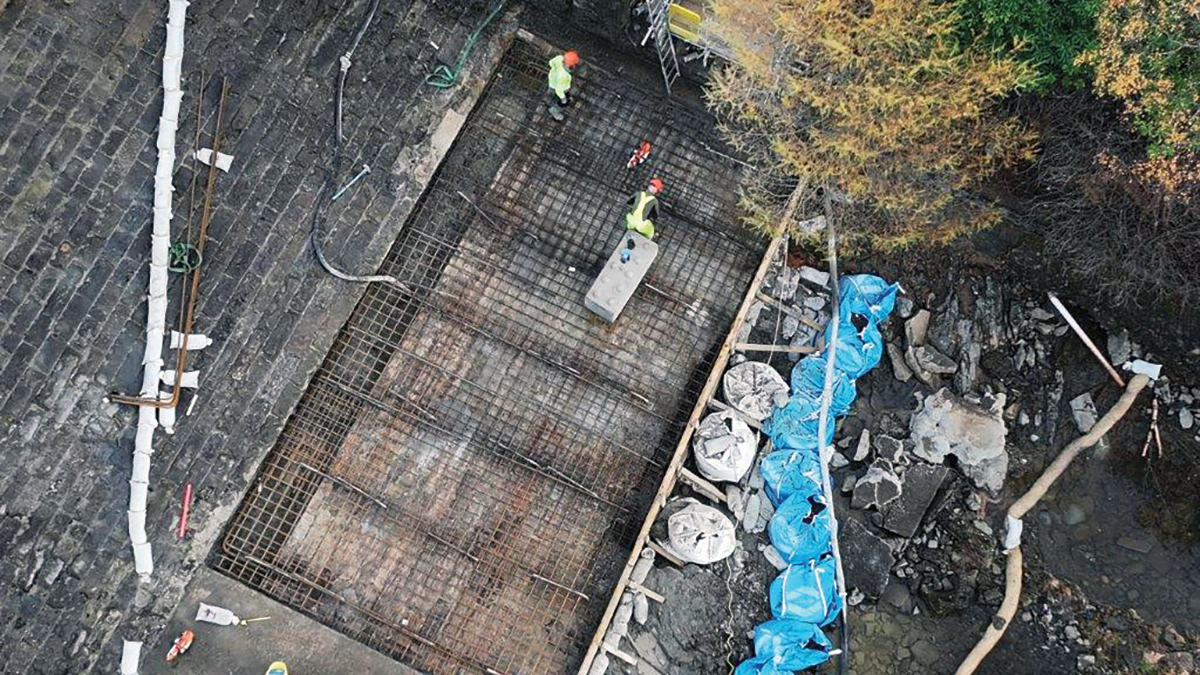
Installation of fabric mesh and environmental protection – Courtesy of Whitehouse Studios
Before full mobilisation, preparations for the crane pad were deliberated and built on-site in anticipation of positioning the 60-tonne mobile crane. Concurrently, during these initial phases, nearby residents received briefings about the projected plan and what they could anticipate in the ensuing weeks. This practice of keeping the local community informed was maintained consistently during the project’s duration.
Regular meetings involving all parties (Scottish Water, George Leslie Ltd and Mott MacDonald) took place every day to review what was needed for the investigation, which would then inform the design stage. Excavation work was carried out to reveal specific areas of the spillway construction. These findings were relayed to Mott MacDonald, contributing to the progression of the design, ensuring a smooth flow from investigation to design, then to planning and execution.
The project’s schedule of work was frequently revised, often in response to planning made during Teams calls. It necessitated regular updates and rebriefing for the onsite team.
Managing environmental pollution was particularly demanding while the reservoir continued to spill over.
On-site logistics posed difficulties with spatial constraints and the necessity to maintain operations at the Loch Katrine steamship workshop throughout the construction period. Careful scheduling of deliveries and the selection of specific transport machinery to accommodate the dimensions and configuration of the access route were vital for ensuring safety and preventing any obstruction in the vicinity of the access path and work zone.
The George Leslie Ltd supply chain team demonstrated exceptional flexibility with the project, expediting delivery schedules, facilitating deliveries outside of normal business hours, and reorganising their work to be on-site for the urgent repairs. Such dedication was instrumental in ensuring the emergency work was completed smoothly.
The project required consultation, inspection, and design to carry out repairs to safeguard the listed structure at the reservoir. This included daily meetings set up by the client for reporting.
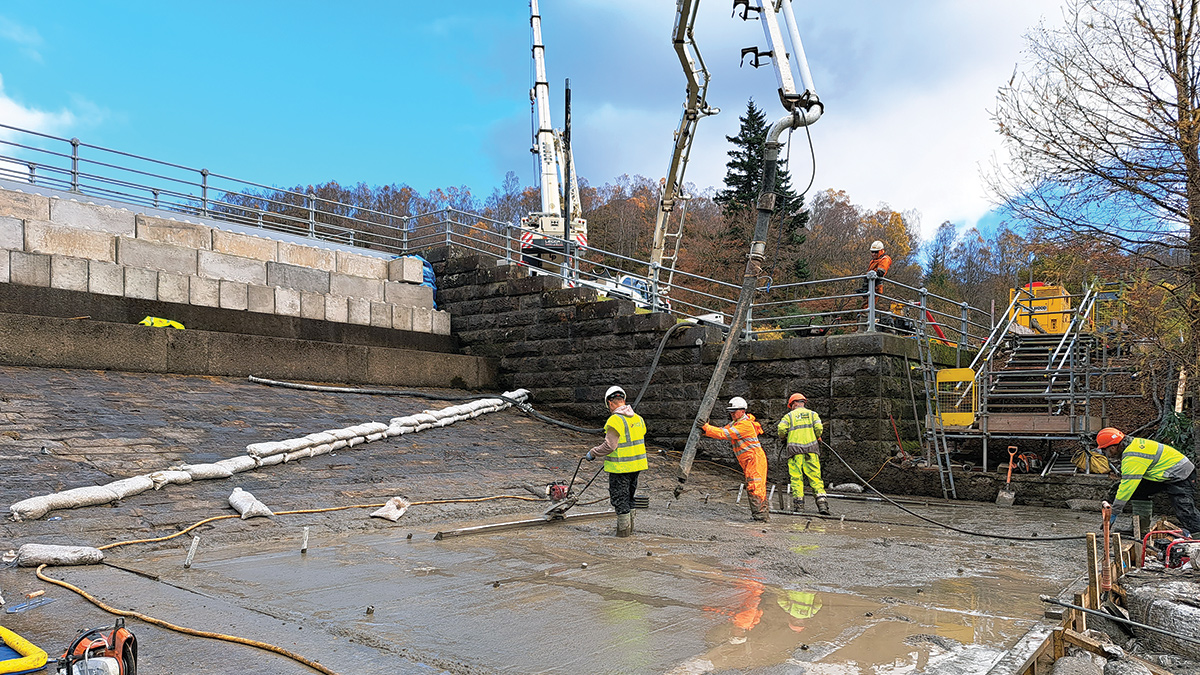
Repairs to concrete apron underway – Courtesy of George Leslie Ltd
Implementation and Health & Safety
Due to access challenges with a single track road to the site, the size of equipment utilised was limited. The main tasks included the innovative use and the installation of Legato Blocks, to potentially reduce flows over the weir and divert away from the construction area. Reservoir drawdown, silt mitigation, drilling and fixing L-Bars, installing mesh and formwork, pouring concrete, and installing pressure relief pipes was also required.
Health and safety was paramount, with rigorous risk assessments, emergency procedures, safety training, incident reporting, and monitoring compliance forming the backbone of the project’s safety culture.
Impact & benefits
Scottish Water is a public sector body answerable to the Scottish Parliament through Scottish Ministers and our principal activities are the supply of water and waste water services to around 5.4 million customers in homes and businesses across Scotland covering an area of 30,810 square miles.
Our vision is to be trusted to care for the water on which Scotland depends. Reflecting that, our customers expect us to provide excellent customer service by delivering high levels of water quality and environmental performance, all for an affordable price. Using Scotland’s natural resources and the skills of our people, Scottish Water is committed to improving our services for customers and communities while protecting and enhancing the environment of Scotland.
This project not only restored the dam’s functionality but also reinforced its structure against future threats, ensuring the continued safety and security of water supplies to Milngavie WTW and Balmore WTW. It also addresses the major business risk associated with loss of supply to these strategic assets, which output potable water to a population of approximately 1.3 million people in central Scotland and provides vital water for commercial and industrial use.
This project is important to Scottish Water as it continues to build the trust and confidence of customers and communities across Scotland by maintaining and investing in the company’s assets.
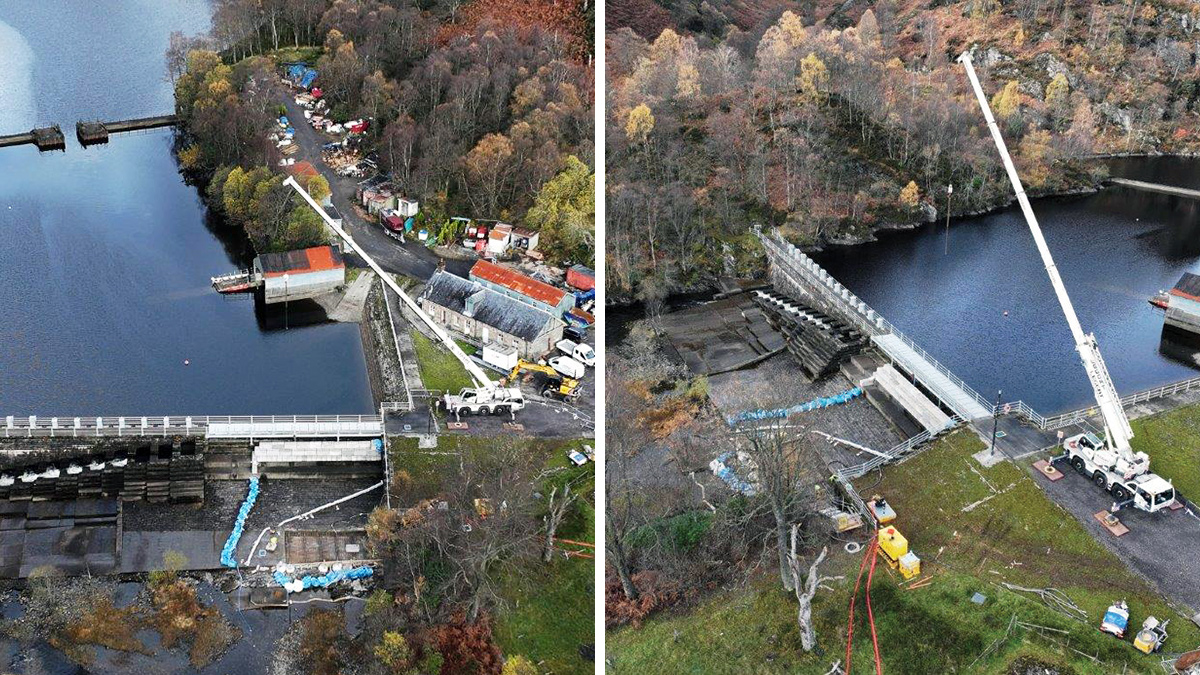
Katrine Dam: (left) looking north prior to concrete pour and (right) looking west- Courtesy of Whitehouse Studios
Conclusion
The Loch Katrine Emergency Dam Project stands as a shining example of engineering excellence, showcasing the ability to swiftly and safely respond to emergency situations while maintaining a strong focus on health and safety. The next phase of the work is already underway, promising to further solidify the dam’s role in safeguarding the region’s water supply.



